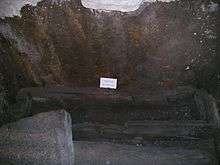Saint Martial
Saint Martial (3rd century), called "the Apostle of the Gauls" or "the Apostle of Aquitaine", was the first bishop of Limoges. His feast day is June 30.
Saint Martial | |
|---|---|
Saint Martial receives the pastoral staff from Saint Peter. | |
| Bishop | |
| Died | 3rd century prob. Limoges |
| Venerated in | Eastern Orthodox Church, Roman Catholicism |
| Major shrine | Shrine of St Martial in the church of St Michel des Lions, Limoges. |
| Feast | June 30 |
| Attributes | episcopal attire |
Life
There is no accurate information as to the origin, dates of birth and death, or the acts of this bishop. According to Gregory of Tours, during the time of the Emperors Decius Pope Fabian sent out seven bishops from Rome to Gaul to preach the Gospel: Gatien to Tours, Trophimus to Arles, Paul to Narbonne, Saturnin to Toulouse, Denis to Paris, Austromoine to Clermont, and Martial to Limoges. He succeeded in converting the inhabitants to Christianity, and his memory has always been venerated there.[1]
Abbey

Martial died in Limoges and was buried outside the Roman town. As his tomb became progressively more important as a pilgrimage site, the monks found patronage in the Benedictine order in the 9th century. The site became the Benedictine Abbey of Saint-Martial, a great library (second only to the library at Cluny) and scriptorium. The 12th-century chronicler Geoffroy du Breuil of Vigeois worked in its library.[2]
The abbaye de Saint-Martial, one of the great pilgrimage churches of western Christianity, was so thoroughly razed in the 19th century, that only the scattered manuscripts of its library remain. Some of said manuscripts had been bought for Louis XV and have come to the Bibliothèque Nationale de France. The original crypt was exhumed in 1966–1970. Twelve Romanesque carved capitals were discovered built into the foundations of a barn and purchased in 1994 for the Museum of the Bishopric of Limoges.
Hagiography
The Miracula Martialis, an account of 7th-, 8th- and 9th-century miracles, was written shortly after 854.
The influx of pilgrims to the abbey where the historical Martial lay buried encouraged the creation of an elaborate hagiography during the 10th century. As the hagiography grew, Martial was moved back in time: now, sent into Gaul by Saint Peter himself, he is said to have evangelized not only the Province of Limoges but all of Aquitaine. He performed many miracles, among others the raising of a dead man to life, by touching him with a rod that Saint Peter had given him.[1]
The mythology culminated in the 11th century forgeries of Ademar of Chabannes, The Life of St. Martial, attributed to Bishop Aurelian, his successor, which was designed to 'prove' that Martial had been baptized by Peter, was one of the seventy-two disciples and present at the Last Supper.[1]
In the 13th century compendium of lore, the Golden Legend, the legendary Martial appears with many miracles, casting out fiends and raising the dead and conducting mass baptisms.[3]
In the midst of a revival of his cult in the 14th century, 73 miracles were recorded between 1378 and 1388 in the Miracula sancti Martialis anno 1388 patrata.
As late as 1854, Mons. Buissas, Bishop of Limoges, petitioned Pope Pius IX to bestow on Martial the honors of a disciple of Christ, but was turned down. The full discovery of Ademar's tissue of forged documents, including an imaginary church council and a papal letter, was not revealed until the 1920s, and continued for several generations to be resisted in conservative Catholic circles.
Saint Martial also became associated with Saint Valerie of Limoges, a legendary martyr of the 3rd or 4th centuries, who is said to have carried her head to him after decapitation.
Veneration
His help was invoked during an epidemic of widespread ergot poisoning in Limoges in 994.[4] Martial was particularly honored in Bordeaux, where his pastoral staff was kept in the Basilica Saint-Seurin and used in processions to invoke his aid during outbreaks of pestilence.[5] He is also venerated in Italy, where Colle di Val d'Elsa Cathedral is dedicated to him.
The Cloisters has a 12th-century stained-glass window of "Saint Martial Founding the Cathedral of Saint-Pierre".[6]
St. Martial's chapel at the Papal palace in Avignon was used for deliberations during conclaves.[7] Saint-Martial Temple, a gothic church in Avignon was completed in 1402.[8]
Gallery
 Cupboard of the Arm, where a medieval reliquary containing the arm of Martial was stored.
Cupboard of the Arm, where a medieval reliquary containing the arm of Martial was stored. Shrine of St Martial in the church of St Michel des Lions, Limoges, where the relics have been stored since the dissolution of the abbey
Shrine of St Martial in the church of St Michel des Lions, Limoges, where the relics have been stored since the dissolution of the abbey A statue of St Martial at the Ermita de San Marcial de Limoges, Femés, Lanzarote (he is the patron saint of Lanzarote)
A statue of St Martial at the Ermita de San Marcial de Limoges, Femés, Lanzarote (he is the patron saint of Lanzarote)
Notes
- Clugnet, Léon. "St. Martial." The Catholic Encyclopedia Vol. 9. New York: Robert Appleton Company, 1910. 10 January 2016
- Charles de Lasteyrie, L'Abbaye de Saint-Martial de Limoges (Paris) 1901.
- "Saint Martial", Treasures of Heaven
- "Saint Martial", Cathédrale Saint Etienns, Limoges
- "Saint Martial de Limoges", Nominis
- "Saint Martial Founding the Cathedral of Saint-Pierre", Metropolitan Museum of Art
- "St. Martial's Chapel", Palais des Papes
- "Saint-Martial Temple", Structurae
External links
